BY ROB FELD
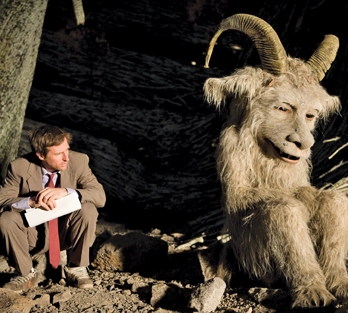 WILD THING: Spike Jonze, with a friend from Where the Wild Things Are,
WILD THING: Spike Jonze, with a friend from Where the Wild Things Are,
wonders if anyone could make a film like The Black Stallion anymore.
He's a rare filmmaker with such a delicate touch," says Spike Jonze, settling in to watch Carroll Ballard's The Black Stallion. "He's like Terrence Malick in a way: very patient and confident."
Jonze has chosen to screen the film about a boy and the horse he loves because of the influence it had on his last movie, Where the Wild Things Are. Maurice Sendak, who wrote the children's book it was based on, had suggested he see it again. "I remember loving this movie as a kid," says Jonze. "When I re-watched it, I was astounded by the beauty of the relationship. The first 45 minutes, with almost no dialogue, is always what gets me. It captures the point of view of a boy observing the world."
Ballard's treatment of Walter Farley's novel follows Alec Ramsey (Kelly Reno), who saves, and in turn is saved by, a powerful black stallion. The boy is traveling with his father (Hoyt Axton) on an ocean liner, and Ballard introduces the boat as a wonderland inhabited by strange characters. "One of the great things about the film was the casting, the specialness of the boy Ballard found, and the way he worked with him," says Jonze. "The boy had never acted before, but the movie wouldn't have worked if they didn't have this kid who's face you could hold on in silence for long scenes, and understand what he's feeling."
Alec hides onboard as he watches exotic-looking men fighting to cage a wild, baying horse. As it kicks and rears, Ballard creates a sense of mystery by fragmenting the horse in close-ups or otherwise obscures him from the camera's full view. Alec's interest is peaked. "It's a very subjective movie," Jonze observes. "Not every shot is from the boy's point of view but it feels like it is. Ballard never cuts out wide to see the boy and the horse together. This horse is larger than life and fills the frame."
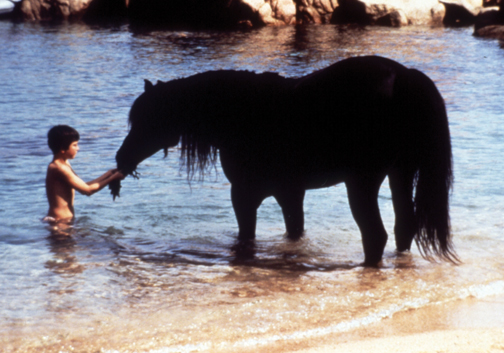 Alec (Kelly Reno) finally bonds with the Black Stallion. (Photo Credit: Photofest)
Alec (Kelly Reno) finally bonds with the Black Stallion. (Photo Credit: Photofest)
Jonze is also taken by Ballard and cinematographer Caleb Deschanel's expressive use of light as Alec lays in the cabin at night gazing at a stallion figurine, both a trophy and object of desire that his father won at poker. The keeling boat and coming storm are suggested by golden light that illuminates the figurine like fire, until it topples to the floor. "To have the moment created entirely by the shifting of the boat, that's some control of lighting right there," Jonze says excitedly. "The light shifts on the figurine and gives it this strange under-glow. The sound design is just this creaking of the boat, accenting the light."
When the storm hits, Alec and his father are thrown into the panic and chaos of a sinking ship, captured by a handheld camera following them through gushing water, flames and screaming people. "Look at how personal it is and true to the experience," Jonze says. "The whole movie is so experimental. Ballard isn't a filmmaker commenting on it at all. He's a filmmaker that's making the film feel like it's making itself. Obviously it takes immense effort to make something feel that effortless, but the camera's not doing anything fancy."
"Look at that! That's so scary!" Jonze laughs, as the stallion's owner cuts off Alec's life preserver with a large knife and steals it for himself. "Wow! Look at the flame and the water. I wonder if they had the set rocking because it really feels like it was, but I can't imagine them being able to do that. God, that's a lot of water. That's epic." Jonze studies the scene. "I wonder if he storyboarded it because it doesn't feel that way at all, but there are so many beats he would have had to work out."
The stallion jumps overboard and Alec is thrown into the water after him. Ballard's camera, guided over and under the water by Deschanel, catches the spinning propeller, kicking legs, sinking boat, and struggling horse in almost sepia tones. "How would they make a movie like this nowadays?" Jonze says, almost posing the question to himself. "What film is this visceral? It's the boy's POV under and above water; then he comes up and he's catching his breath, and there's this giant, creaking propeller, smoke and fire. You see him struggle, you see his fear, his aloneness in the ocean and the chaos."
Alec grabs a rope tied to the stallion and is towed to safety, and later awakens on a deserted island. He begins to explore and the next half hour of the film is spent without dialogue as Alec earns the stallion's trust and the two bond inseparably. "Every shot is so beautiful," Jonze says, shaking his head. "It's weird analyzing this. You have to imagine somebody filming it, but you don't feel the filmmaker at all. It feels like it just exists. I always aspire to that, where it feels like the film was made by the characters as opposed to the filmmakers. I try to be invisible."
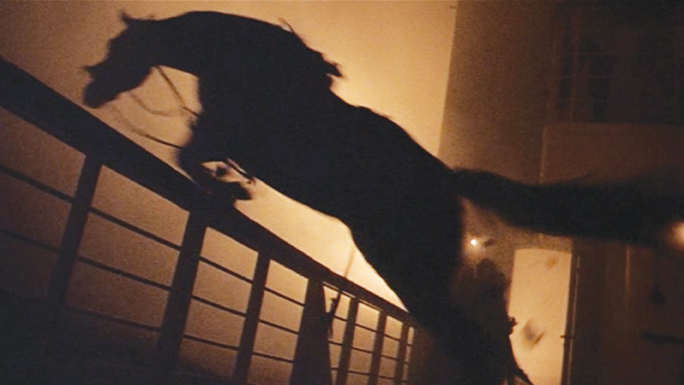
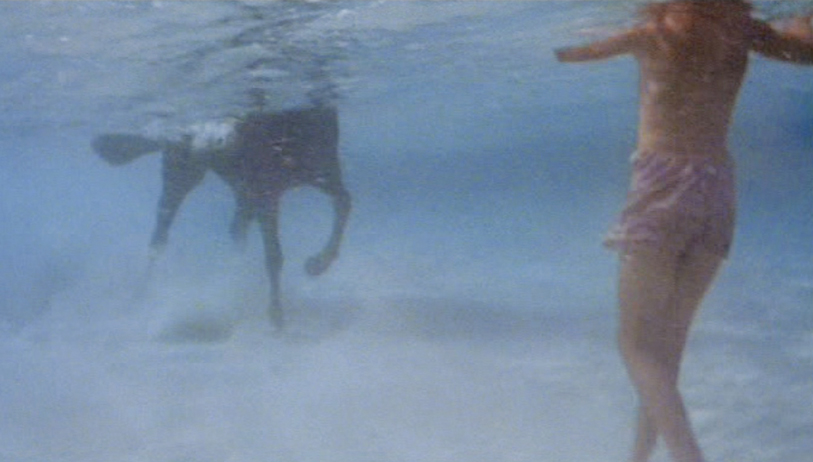
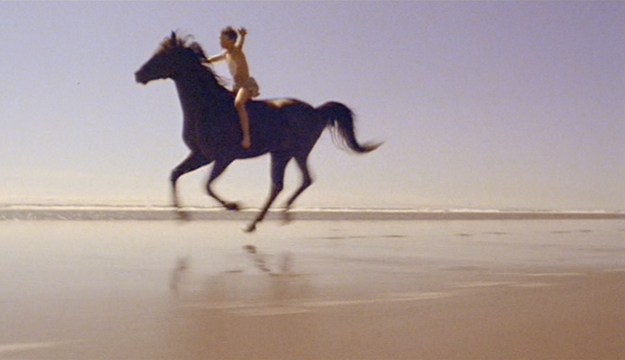 Alec and the Black Stallion flee from a sinking ship
Alec and the Black Stallion flee from a sinking ship
during the storm. Ballard shot underwater as Alec
gets ready to mount the stallion for the first time.
Adjusting to life and survival on the island, Alec and the stallion have two brief run-ins where they again save each other, all leading up to the stunning ballet Ballard choreographs in which the boy wins the stallion's trust and friendship. Accompanied by Carmine Coppola's eastern percussion on the soundtrack, the camera leads us into the sequence's climax by holding the boy and the horse silhouetted against the surf in a single two-shot for more than a minute, as they approach and retreat from each other until the stallion finally takes a bite of seaweed from Alec's outstretched hand. "It's amazing, the dance of trying to get closer," Spike says, his eyes and ears glued to the screen, as Alec holds out an offering. "Getting the horse to come a little closer, the horse gets scared away, then the shot of the seaweed and the shot of the nose, the smelling."
Jonze marvels at the animal training alone required to get this shot. "They're funny together in a real, subtle way. It's all staged against the reflection of the ocean in that late afternoon light. And the patience! Trying to shoot Wild Things in nature [I discovered] weather can be uncooperative."
As the stallion finally takes the seaweed from Alec's hand, the score breaks into soft piano chords, joined by a snake charmer's flute, and the two new friends chase each other along the beach in magic-hour light. Jonze is clearly touched by the emotion of the moment. "It's weird because this movie has so much heart but it's not in the least bit schmaltzy or manipulative," he says. The frolicking quiets as they stand in close-up, and Alec comes to embrace his new companion.
"That moment is so natural, not covered, just observed," Jonze notes. "Ballard just lets them be together, and lets the boy be half-obscured for most of the shot—the best words to describe it are confident and open. It's not what you would imagine when you think of a shot of a boy hugging a horse, and being the moment when they finally bond. I would imagine something more straightforward but this has so much feeling to it. Sometimes when I see a shot that is so unconventional but has so much feeling, I think I would have messed it up out of fear that it wouldn't work, that you have to see their faces more. But the way he did it is so much more evocative."
The story continues with the inevitable next step. In shallow, crystalline water, we see Alec's feet backing up in the sand. Then come hooves. "Then a little deeper," Jonze narrates. "Now it's waist-deep and the horse is following him and it's just their legs. What are they doing? You have no idea, but it's getting deeper, the boy's up to his shoulders now. Now it's too deep for him to stand and he's got to swim. It's all underwater. He swims up to the horse and from under the water you see that he's climbed on. It's quietly magical. We're 42 minutes into the film and the boy's just ridden him for the first time."
Jonze is exhilarated by this bit of filmmaking, pointing out that Ballard again shows only pieces of his subjects—forcing the viewer to question and wonder, to fill in the missing pieces. "You're trying to catch up. It's like, why are we here? And then you're seeing his legs, then the horse's legs, and you still don't know exactly what the boy is thinking. It's really assured filmmaking to let the audience be that far behind the movie at that moment. Ballard just lets it play out. You feel their chemistry, even though you're only seeing their legs. It's pretty wild."
"Ballard is a master at work in those moments," Jonze continues. "He has the certainty to do it all without dialogue, not to have the kid talking all the way through it. And not to anthropomorphize the horse at all, to just let the horse be a horse. I think my tendency would have been to give the horse a more humanistic personality."
It's 47 minutes into the film before Alec has his first bit of dialogue, when he's finally rescued by fishermen. They try to take him off the island without the horse. Jonze picks up on the way the music underscores the horse's character and the decision the stallion makes. "It plays to his panic, then takes a pause for him to gather his thoughts and make his decision to swim out to join the boy."
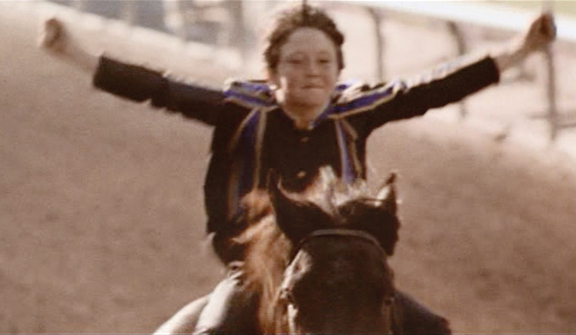 As the boy thungers to the finish line, the sound makes it feel like the viewer is on the horse.
As the boy thungers to the finish line, the sound makes it feel like the viewer is on the horse.
Now off the island, the film almost becomes a different movie as Alec adjusts to home life and meets up with an old horseman (Mickey Rooney), who trains him to be a jockey and molds the stallion into the fastest racehorse around. "It's funny because the island is the really vivid part of the film that stays with you, but as a kid I also loved watching him become a jockey. It was really satisfying as a kid to see him get to do that."
Jonze points out that although the film has moved away from the exotic locales, it still has a distinctive look. "The confidence in the photography is amazing, just letting things be in shadow," says Jonze. "Look at this wide shot where Rooney is explaining how to race to the boy. It's happening in a wide shot. There's a little light flare at the top from some streetlamp that's just framed out. And they're silhouetted against a big, heavy sky, with the earliest morning light. Letting a scene play like that, without adding any light, and having a streetlamp up there but not putting it in frame, that's something special."
As Alec and the stallion thunder into the big race that closes the film, Jonze's attention turns to the subtlety of the sound design. "It's really sparse and specific but evocative," Jonze notes, as the emphasis moves between the cheering crowd, pounding hooves and the soundtrack's rising chords. "The sound helps make everything subjective because in those moments you don't hear the crowd, you don't hear anything. It feels like you're on that horse, feeling the power and the hooves and the dirt. There's none of the announcer or kind of stuff you'd think it would have to build excitement. Ballard never gets too fancy or in his own way. He doesn't dare mess it up with anything unnecessary."
As the end credits roll, Jonze uncurls in his chair and considers why the film moves him so much every time he sees it: "Watching them in the last race scene, and how perfectly it's shot, reminds me of the end of [the documentary] When We Were Kings, where Muhammad Ali knocks out George Foreman. Foreman is stumbling around and Ali is about to deliver another blow and instead restrains himself and lets this perfect moment happen, where Foreman falls to the ground. Norman Mailer says had Ali hit him again while he was falling, it just would have made it ugly. And that's what The Black Stallion is like. Ballard never goes for that extra blow. He puts it in motion and lets it be."